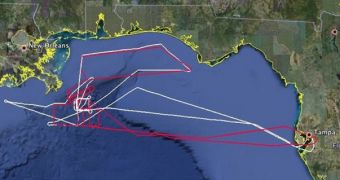Officials at the US National Oceanic and Atmospheric Administration (NOAA) released a complete report on the quality of the air around the Deepwater Horizon/BP oil spill area yesterday, July 21. The document is based on measurements that the agency collected around the disaster site in June. More than 100 air pollutants had their levels measured via complex air-sampling equipment. The research was conducted with an advanced NOAA surveillance plane, the WP-3D research aircraft.
“Data from the NOAA flights are providing an important detailed and independent set of air quality data to assess air quality risks of workers at sea and the public ashore,” reveals the director of the NOAA Earth System Research Laboratory (ESRL) Chemical Sciences Division, A. R. Ravishankara. The expert was also the leader of the science team that conducted the assessment. He says that pollutants commonly found in air samples, such as carbon dioxide, carbon monoxide, nitrogen oxides and ozone, were found to exist in quantities equivalent to those found in crowded urban areas.
While this finding was valid at some locations around the spill site, different readings were recorded 15 to 70 kilometers away from the former site of the Deepwater Horizon drilling rig. At these locations, certain hydrocarbons were found to exist in concentrations that exceeded discovered in polluted urban air. The chemicals were however made up of organic elements, which is not the case above densely-populated cities. Additionally, important amounts of black carbon were found in the air. The NOAA team determined that the substance most likely came from a controlled burn of the oil slick. As the disaster unfolded, authorities tried using fire to stop the slick from spreading, but they failed.
“EPA [the US Environmental Protection Agency] has been monitoring air quality along the Gulf Coast since the start of this incident to ensure that residents have the best possible information on the air quality, and the data in this report are generally consistent with EPA’s findings. EPA will continue to work with NOAA, other federal agencies and independent scientists to effectively monitor air quality and to provide residents living along the coast with the best possible information about the air they are breathing,” says the EPA Assistant Administrator for the Office of Air and Radiation, Gina McCarthy.
“In order to evaluate worker exposure, OSHA[the US Occupational Safety and Health Administration] has been conducting its own air monitoring in the Gulf, as well as reviewing all additional available data. Our findings are consistent with NOAA’s data. We will continue to work closely with all other Federal Agencies to monitor the health and safety hazards facing workers involved in the oil spill response,” concludes the Assistant Secretary of Labor for Occupational Safety and Health, Dr. David Michaels.

 14 DAY TRIAL //
14 DAY TRIAL //